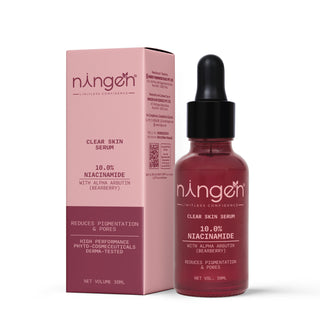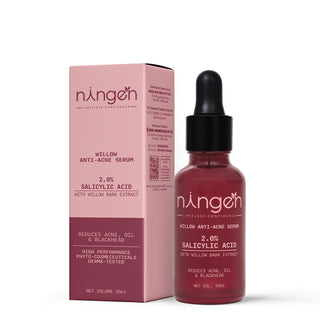TLDR;
If your skin constantly feels greasy yet dehydrated, it’s time to rethink your routine. An oil-free moisturizer gives your skin the hydration it needs, without clogging pores or triggering excess shine. Infused with humectants like hyaluronic acid and soothing aloe vera, these lightweight formulas balance oily, acne-prone, and combination skin while keeping it fresh, matte, and healthy.
Ever wondered why your skin feels oily yet still dry and tight by midday? You’re not imagining it, your skin’s sending you a hydration SOS. That’s where an oil-free moisturizer comes in, the secret to balanced, shine-free hydration. In fact, if you’re noticing constant greasiness, breakouts, or makeup that won’t stay put, it might be time to ask yourself: Should you be using an oil-free moisturizer? Here are 5 signs that say yes, and how making this simple switch can completely transform the way your skin looks and feels.
In this Guide;
What Exactly Is an Oil-Free Moisturizer?
5 Signs That Say You Should Be Using an Oil-Free Moisturizer
The Right Way to Apply Oil-Free Moisturizer
What Exactly Is an Oil-Free Moisturizer? (And Why Does It Matter?)
Think of your skin like a sponge. Some sponges require oil to remain supple, while others simply need water-based hydration. An oil-free moisturizer skips traditional oils (such as coconut, jojoba, or mineral oil) and instead uses water-based ingredients, including humectants like hyaluronic acid, and lightweight emollients.
According to the American Academy of Dermatology, the right moisturizer should match your skin type and concerns. Oil-free formulas are specifically designed for people whose skin produces enough natural oil (sebum) on its own, or maybe a little too much.
The Science Behind Oil-Free Formulas
Here's where it gets interesting. Your skin has something called the sebaceous glands, which naturally produce oil to protect and hydrate. When you have oily or combination skin, these glands work overtime. Adding more oil to your moisturizer? That's like pouring gasoline on a fire.
Oil-free moisturizers use ingredients like:
-
Hyaluronic acid – Holds 1000x its weight in water
-
Glycerin – A humectant that draws moisture from the air
-
Niacinamide – Regulates oil production and minimizes pores
-
Dimethicone – A breathable silicone that won't clog pores
-
Aloe Vera – Provides non-greasy soothing hydration
Avoid these red flags:
-
Comedogenic oils (coconut oil, certain mineral oils)
-
Heavy silicones (cyclomethicone in high concentrations can irritate some)
-
Fragrances (potential irritants)
-
Alcohol as a primary ingredient (can over-dry)

5 Signs That Say You Should Be Using an Oil-Free Moisturizer
1. Your skin feels greasy by mid-morning (or your makeup starts sliding)
Pain point: You apply your morning moisturiser, but by lunchtime, your T-zone looks slick, your pores look larger, and your finishing powder isn’t doing its job. You then reach for blotting sheets. Sound familiar?
What’s happening: Excess sebum + heavy/occlusive moisturizer = a glossy, congested finish. According to the American Academy of Dermatology, oily skin still needs moisture, but the formula must support hydration without adding oil.
Solution: Switch to a lightweight oil-free formula that absorbs quickly and doesn’t add to the oil load. A gel-or-lotion texture works best for this scenario.
2. You’re acne-prone or have enlarged pores (and are afraid of clogging)
Pain point: You’ve tried moisturisers but avoid them because you fear “it’ll make me break out”. You’re constantly checking if a new product caused a comedo or inflamed bump.
What’s happening: Moisturizers labelled oil-free and non-comedogenic reduce the risk of pore-clogging and are better suited for oil-producing skin types. In fact a study found that moisturizers can improve acne when they’re appropriate.
Solution: Opt for an oil-free formula explicitly labelled “non-comedogenic,” with humectants like hyaluronic acid or glycerin (they hydrate without oil) plus soothing botanicals like aloe vera. These support barrier health and reduce breakout risk.
3. Your skin is oily but still feels “thirsty” (yes, it’s dehydrated)
Pain point: You splash water, use mattifying products, but still feel tightness or discomfort. You think oily = hydrated, but it isn’t.
What’s happening: Skin can be oily but short on water. According to Verywell Health, oily skin still needs moisture; when you skip it, your skin may over-produce oil to compensate.
Solution: Use an oil-free moisturizer with strong humectants (e.g., hyaluronic acid, sodium hyaluronate) that draw water into your skin without adding oil-based thickness. This reduces that “tight but shiny” contradiction.
4. You live in a humid/hot climate (or have a full-on active lifestyle)
Pain point: The moment you step outside or into a sweaty commute, you feel product melting, pooling, or clinging. Your skincare feels too heavy.
What’s happening: In high-humidity or high-activity conditions, thick, rich creams can trap sweat and oil, causing discomfort and shine. Dermatology texts recommend gel-based or lightweight oil-free moisturizers for combinations like these.
Solution: Select an oil-free formula marketed for “mattifying,” “shine-control,” or “weightless hydration.” These absorb fast, layer well under SPF or makeup, and handle sweat/sun-exposure stress better.
5. You’re using active treatments (retinoids, acids) and your skin barrier is vulnerable
Pain point: You’ve introduced a retinol, BHA, or exfoliant into your routine, and your skin is a bit reactive, with fine lines of dehydration, occasional flakes, and maybe sensitivity. But you don’t want to add a heavy, rich cream that’s too occlusive.
What’s happening: Active treatments often compromise barrier function and make skin prone to dehydration, redness, or irritation. A light oil-free moisturizer helps buffer these effects without overloading skin with oil or occlusives.
Solution: Choose an oil-free moisturizer with barrier-supporting ingredients (ceramides, niacinamide) and humectants, guaranteed to layer with your actives and protect skin without clogging or heaviness.
Next is your action plan:
-
Assess your skin type honestly
-
Check if you have 2+ of the 5 signs
-
Choose an oil-free moisturizer with the right ingredients
-
Give it 4-6 weeks
-
Adjust as needed based on results
Also read: How to know your skin type?
But Wait. Won't My Skin Get Dehydrated?
This is the #1 myth people believe, and it's time to debunk it.
Oil ≠ Hydration
Your skin needs water (hydration), not necessarily oil (moisture). Oil-free doesn't mean moisture-free. Quality oil-free moisturizers are packed with hydrating ingredients that deliver water to your skin cells.
In fact, the renowned skin clinics note that many people with oily skin who skip moisturizer altogether actually make their skin produce MORE oil to compensate for dehydration. An oil-free moisturizer provides your skin with the hydration it needs without adding extra oil.
The Right Way to Apply Oil-Free Moisturizer
You've got the right product. Don't waste it on the wrong application!
The Perfect Routine:
-
Cleanse – Always start with a clean canvas
-
Tone (optional) – Preps skin for better absorption
-
Treat – Apply any serums or treatments
-
Wait – Give treatments 30-60 seconds to absorb
-
Moisturize – Apply your oil-free moisturizer to damp (not wet, not completely dry) skin
-
SPF – Never skip sunscreen (morning routine only)
Amount: You need less than you think. A nickel-sized amount should cover your entire face. More isn't better; it'll just sit on your skin.
When: Morning and night. Yes, even if you have oily skin. Skipping night moisturizer is one of the biggest mistakes people make.
Common Mistakes People Make (And How to Avoid Them)
Mistake #1: Using "Mattifying" Products That Are Too Harsh
Just because you want to control oil doesn't mean you should nuke your skin. Over-drying with harsh mattifying products makes your skin produce MORE oil to compensate.
Mistake #2: Not Giving It Time
Your skin needs 4-6 weeks to adjust to a new moisturizer. Don't give up after three days because you're "not seeing results."
Mistake #3: Skipping Moisturizer Because You Have Oily Skin
This is self-sabotage. Dehydrated skin = oil overproduction. Use your oil-free moisturizer, even on oily skin.
Mistake #4: Using the Same Product Year-Round
Your skin changes with seasons, stress, age, and hormones. What works in January might not work in July. Stay flexible.
The Bottom Line: Should YOU Make the Switch?
If you recognized yourself in even TWO of those five signs, an oil-free moisturizer is worth trying. The worst that happens? You don't love it, and you switch back. The best that happens? You finally find the product that makes your skin look and feel amazing.
Your skin is unique, and what works for your best friend or favorite influencer might not work for you. Pay attention to how your skin feels and looks, not just what's trending.
Remember: great skin isn't about using the most expensive products or the longest routine. It's about using the RIGHT products for YOUR skin.
Have you tried switching to an oil-free moisturizer? Share your experience in the comments below!
Frequently Asked Questions
Q1: What is the best oil-free moisturizer?
A. The best oil-free moisturizer is one that balances hydration with breathability, keeping skin soft and supple without adding shine or clogging pores. Look for formulations enriched with hyaluronic acid, a powerful humectant that draws moisture deep into the skin, and aloe vera extract, known for its cooling, soothing, and lightweight hydration properties. Together, they deliver a fresh, non-greasy finish ideal for oily, combination, and acne-prone skin, ensuring long-lasting moisture minus the unwanted oil slick.
Q2: Is an oil-free moisturizer good for acne?
A. Absolutely. An oil-free moisturizer is one of the best skincare choices for acne-prone skin. When you skip moisturization, your skin compensates by overproducing sebum, leading to clogged pores and breakouts. An oil-free formula helps maintain balanced hydration without adding excess oil.
Q3: How long does it take to see results from an oil-free moisturizer?
A. Most people notice reduced shine and improved skin texture within 1-2 weeks. For significant improvements in pore size, acne, and overall skin health, give it 4-6 weeks. Your skin needs time to adjust and rebalance its natural oil production.
Q4. Can I use oil-free moisturizer under makeup?
A. Absolutely! Oil-free moisturizers are actually ideal under makeup because they create a smooth, matte base that helps foundation and concealer stay put longer. Wait 5-10 minutes after applying moisturizer before starting your makeup routine.
Q5. Is oil-free the same as water-based?
A. Mostly, yes. Oil-free moisturizers are typically water-based, meaning water is the primary ingredient. However, always check labels—some products marketed as "oil-free" may contain oil-like ingredients (silicones, synthetic oils) that can still clog pores in sensitive skin.
Q6. Should I use an oil-free moisturizer morning and night?
A. Yes! Even if you have oily skin, you need moisture twice daily. Your skin repairs itself at night and needs hydration support. Use your oil-free moisturizer both morning (under SPF) and night for best results.
Q7. Can oil-free moisturizers cause purging?
A. True purging (increased breakouts as your skin adjusts) typically only happens with active ingredients like retinoids or AHAs/BHAs. A basic oil-free moisturizer shouldn't cause purging. If you break out immediately, it's likely a reaction to an ingredient, not purging.
Q8. Are gel moisturizers always oil-free?
A. Not always, but most gel moisturizers are oil-free. Gel formulas are water-based and feel lightweight, making them popular for oily skin. However, always check the ingredient list—some gels contain oils or comedogenic ingredients.
Q9. What's the difference between oil-free and non-comedogenic?
A. Oil-free means the product doesn't contain traditional oils. Non-comedogenic means it won't clog pores (it might contain some oils, just not pore-clogging ones). The best option for oily, acne-prone skin is a product that's BOTH oil-free AND non-comedogenic.
Q10. Can I mix oil-free moisturizer with facial oils or serums?
A. You can layer products, but applying facial oil over an oil-free moisturizer defeats its purpose. If you want to use both, apply oil-based serums BEFORE your oil-free moisturizer so the moisturizer creates a protective barrier. Better yet, choose one approach that works for your skin type.
References:











